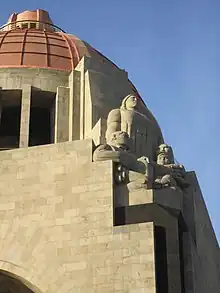Oliverio Martínez
Oliverio Guillermo Martínez de Hoyos (January 30, 1901 – January 21, 1938) was a Mexican sculptor.[1][2][3]

Biography
Oliverio Martínez was born in born in Piedras Negras, Mexico, in 1901.[3] Several of his 15 siblings also went into the arts, including the painter Ricardo Martínez de Hoyos.[4]
Starting in 1925, he lived in New York, working for Ferrocarriles Nacionales de México.[3] Then, in 1927, he became a workshop assistant at Guillermo Ruiz Reyes' Escuela de Escultura y Talla Directa.[2][5] He studied at Mexico City's Escuela Nacional de Bellas Artes from 1928 to 1930.[3] As a member of the so-called Mexican School of Sculpture, he participated in a rebirth of sculptural discourse in Mexico alongside Ruiz Reyes, Carlos Bracho, and others. He studied under Bracho and Luiz Ortiz Monasterio.[2] In 1930, he began working on large-format sculptures in collaboration with Ernesto Tamariz.[2] By 1932, he had gained recognition for his monument to Emiliano Zapata in Cuautla.[6][7]
In November 1933, a committee began considering proposals for Mexico City's Monumento a la Revolución, a major landmark commemorating the Mexican Revolution. Martínez Transformación was named one of the finalists alongside proposals by Federico Canessi and Fernando Leal. After creating life-size 11-meter models of his four proposed sculptures—La Independencia, Las Leyes de Reforma, Las Leyes Agrarias, and Las Leyes Obrera, Martínez won the competition and contributed the sculptures to the structure.[6]
In 1936, Martínez became interim director of the Escuela de Escultura y Talla Directa. Working in New York a decade earlier, he had contracted debilitating tuberculosis, and he died in Mexico City at the young age of 36.[3]
Notable works
- Sculpture of Emilio Carranza in Saltillo (1930)
- Sculpture of Emiliano Zapata in Cuautla (1932)
- Sculptures La Independencia, Las Leyes de Reforma, Las Leyes Agrarias, and Las Leyes Obrera on the Monumento a la Revolución, Mexico City (1934)
References
- Noguera, José Rogelio Alvarez; Laguna, Amado Tovilla (1975). Enciclopedia de México (in Spanish). Instituto de la Enciclopedia de México.
- Arteaga, Agustín (2006). "La Escuela Mexicana de Escultura". Repositorio de Tesis DGBSDI (in Spanish). Retrieved 2023-03-13.
- "Oliverio G. Martínez, 1901-1938". Colección Blaisten. Retrieved 2023-03-13.
- "Fallece el artista plástico Ricardo Martínez de Hoyos". Vanguardia MX (in Mexican Spanish). 2016-03-02. Retrieved 2023-03-13.
- Ruiz, Guillermo; Sánchez, Ma Estela Duarte (2010). Guillermo Ruiz y la Escuela Libre de Escultura y Talla Directa (in Spanish). Consejo Nacional para la Cultura y las Artes. ISBN 978-607-7622-77-2.
- Benjamin, Thomas (2010-01-01). La Revolución: Mexico's Great Revolution as Memory, Myth, and History. University of Texas Press. ISBN 978-0-292-78297-6.
- "Zapata de Oliverio G. Martínez en Museo Blaisten". Collección Blaisten. Retrieved 2023-03-13.